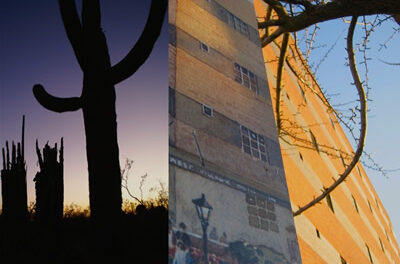Musicians and visual artists make good partners. This has been particularly true since the advent of film. On this occasion, new music fans were treated to a multi-media piece, hot off the press, by Chapel Hill natives Trev Wignall, a violinist, composer, and arranger, and Dylan Wignall, a visual artist specializing in sculpture. Trev Wignall performed the composition he calls Fringeworld at the ArtsCenter in Carrboro.
Trev Wignall, a 2014 graduate of Berklee College, writes and arranges electronic music; he performs in local clubs and teaches in the Triangle (Raleigh, Durham, and Chapel Hill). This performance was unique in that he performed electronics and electric violin along with projections of his brother’s digital work. Dylan Wignall is a student at Southern Methodist University.
Fringeworld is the Wignalls’ first major installation. Not surprisingly, they worked on it together over the Internet by Skype and electronic mail. Since Dylan was absent, Trev Wignall described his brother’s creative process for the piece: he made clay models, scanned them on the computer, and then sculpted them digitally. He refers to the end result as virtual sculpture gardens. Trev Wignall then created music tracks he subsequently performed with live electronics and electric violin improvisations.
The composition is in three parts. The first is an electronic wooded landscape. Immediately, I found myself pulled into the visual world as if I were driven in some sort of powered vehicle. The monochromatic world consists of metallic-looking posts with sculpture along the way; dreamscapes that slowly change in density. Gradually the volume of the music and the speed of the scenery increased. I was glad that I brought hearing protection. Like taking a childhood car trip, I thought “are we there yet?”
Saved by my own memories, I thought about early-20th-century experimental films by Man Ray and Marcel Duchamp – and particularly Duchamp’s painting Nude Descending a Staircase. These memories were triggered by the art in front of my very eyes.
The second part begins with horizontal lines – white on black. Figures from the first part are superimposed. Dylan Wignall used negative space, close-ups, and rotating figures. Visually, this section is more interesting, yet there was nothing to keep me there – until the last section, where a star-lit background grabbed my attention and gently took me away. Unfortunately, the piece lacks a narrative arc, and I felt lost.
Trev Wignall’s electric violin playing was quite wonderful. He played with ease and grace. But his act was a bit like a one-man-band; he picked up the violin, put it down, and then returned to the electronics. Fringeworld has an interesting edge to it but lacks the connective tissue to pull it all together. I’m not sure that this show is yet ready for the road.
Editor’s Note: A much larger Fringe World takes place in and around Perth, Australia.











